Setup: Enable audio/video communication with Remote Desktop Services (RDS)
January 2024
Introduction
In principle, an RDS environment must be tested for its practical suitability for real-time communications as part of a proof of concept with a selected user base of the end customer.
This document describes the settings that must be made when ProCall is running in a remote desktop connection and audio/video communication is to be used over it.
This scenario has been tested with the following operating systems:
- Windows Server 2012 R2
- Windows 8.1
- Windows 10
Currently only operating systems later than Microsoft Windows Server 2012 R2 are supported.
Settings for audio/video in an RDC
Group policy
Via group policy (distributed or local) the option for redirection is enabled.
Terminal server group policy
On the terminal server (Remote Desktop Services), the redirections for audio must be configured or enabled.
To do this, open the group policy editor on the server and navigate to:
Computer Configuration\Administrative Templates\Windows Components\Remote Desktop Services\Remote Desktop Session Host\Device and Resource Redirection
Enable/disable the following settings:
| Setting | Status |
|---|---|
|
|
|
|
|
|
|
|
Example screenshot: Device and Resource Redirection

Computer Configuration\Administrative Templates\Windows Components\Remote Desktop Services\Remote Desktop Session Host\Remote Session Environment
| Setting | Status |
|---|---|
|
|
Example screenshot: Local Group Policy Editor – Remote Session Environment

Computer Configuration\Administrative Templates\Windows Components\Remote Desktop Services\Remote Desktop Connection Host\Remote Session Environment\RemoteFX for Windows Server 2008R2
| Setting | Status |
|---|---|
|
|
Example screenshot: Local Group Policy Editor – RemoteFX

Client group policy
On the client (Remote Desktop Client) the redirection for locally connected USB devices (in this case the WebCam) must be enabled.
To do this, open the Local Group Policy Editor on the client and navigate to:
Computer Configuration\Administrative Templates\Windows Components\Remote Desktop Services\Remote Desktop Session Host\RemoteFX USB Device Redirection
| Setting | Status |
|---|---|
|
|
Example screenshot: Local Group Policy Editor RemoteFX USB Device Redirection

Note that updating group policies (when group policies become active) depends on several factors. You can find more details about this in the Microsoft documentation:
Remote Desktop Connection Settings
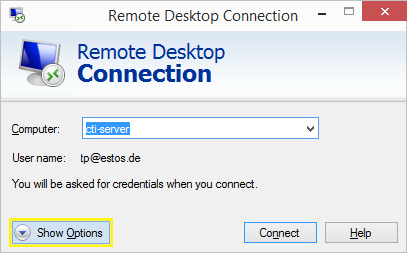
Local Resources >> Remote Audio >> Settings...
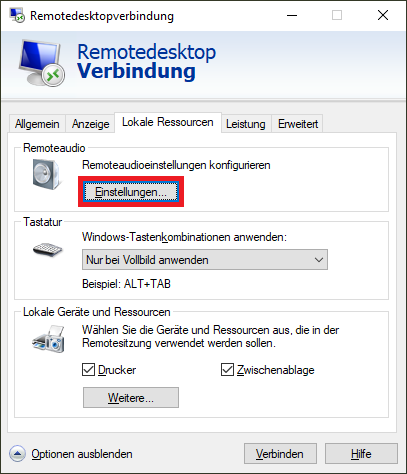
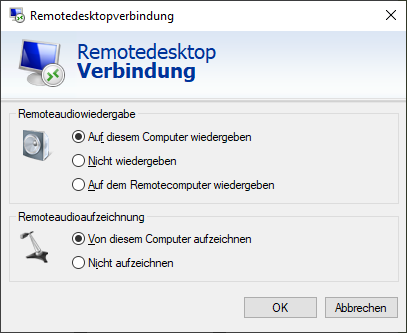
Local Resources >> Local Devices and Resources >> More...
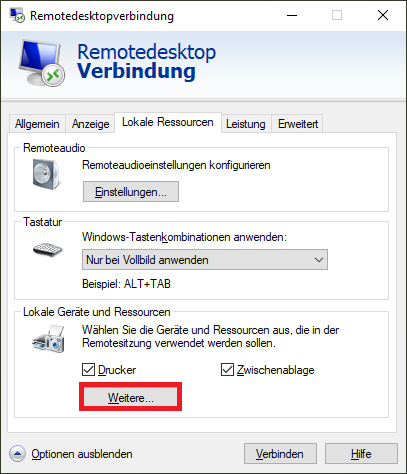
"Other supported RemoteFX USB devices" must be available, but should not be enabled:
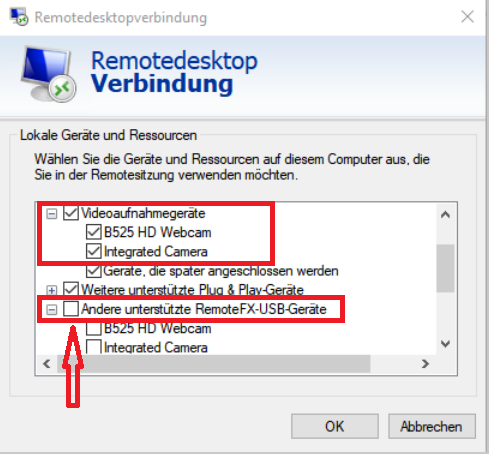
RDP client session configuration check
In Microsoft Windows Microphone Privacy Settings (Settings\Privacy\Microphone), enable the "Allow apps to access your microphone" option.
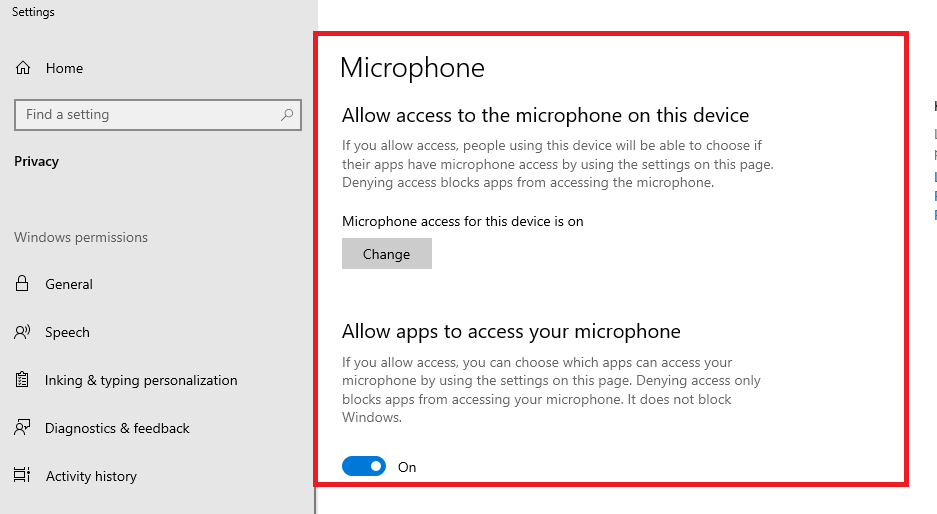
In Microsoft Windows Camera Privacy Settings (Settings\Privacy\Camera), enable the "Allow apps to access your camera" option.

The input and output devices selected in the client (Remote Desktop Client) operating system are available within the RDP session on the Terminal Server under Control Panel\All Control Panel Items\Device Manager as "Remote Audio":
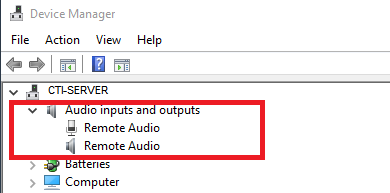
and can be selected in the ProCall Client Audio/Video Wizard under Microphone, Playback Device and Ring tone:
Mitbekommen wenn es klingelt
The remote audio is the headset in the setup. To be able to hear a ringtone on the PC, it is important to select the Windows standard audio device here.
The next step is to select the camera:
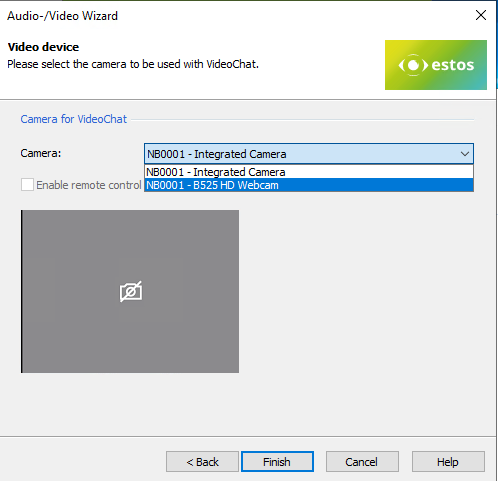
Further technical notes
General operating instructions
Due to the lack of its own optimization options, estos cannot make a generally valid recommendation for softphone operation in the Microsoft Windows Terminal Server environment. The design and utilization of such a topology varies too much from customer to customer, so that the possibility of using ProCall softphones must only be verified on a customer-specific basis within the scope of intensive tests.
Prioritization of audio data
The audioqualitymode:i:1 or audioqualitymode:i:2 setting can be used to statically specify the audio quality in the RDP file at the local client, regardless of the available bandwidth.
See also
- https://docs.microsoft.com/en-us/previous-versions/windows/it-pro/windows-server-2008-R2-and-2008/ff393679(v=ws.10)?redirectedfrom=MSDN
- https://docs.microsoft.com/en-us/windows/win32/termserv/imsrdpclientadvancedsettings7-audioqualitymode
Tests in the lab have shown that the audioqualitymode parameter cannot significantly improve audio quality when Terminal Services is under load. Compressing or reducing the audio packets using this parameter then has no significant effect on the delivery of the RTP packets to the UC Media Server. This means that the RTP packets are received with audible gaps at the Kurento and are thus also forwarded directly to the PBX.
Analysis of audio quality problems
For the analysis of the RTP data stream, a described Wireshark Trace of the Terminal Server and the UCServer (Media Server) as well as a network topology is required: Analysis of softphone behavior
If the analysis shows that data packets are delayed or sent irregularly on the network route or are even lost, no improvement can take place via ProCall, but must be further analyzed and remedied by the integrator in the environment.
Further information
Useful articles
Check if one of the following articles can help:
- Overview SIP telephone systems for ProCall Softphone – compatibility list
- Checklist: Softphone Installation
- Quality of Service (QoS) settings for real-time communications with ProCall Enterprise
- HD Voice/HD Telephony with ProCall Enterprise SIP softphone functionality
- Useful information about STUN/TURN for the use of audio/video and softphone with ProCall Enterprise
- Best Practice: Setting up UCServer for ProCall Mobile Apps
- How to select and test audio devices and video devices for ProCall
- Softphone message "Devices deactivated" and audio/video wizard is grayed out or not available
- Checking the recording/playback of audio devices
- Connect Jabra Evolve 65 headset correctly via Jabra Link 370
- Very low speech volume via the Jabra Engage 65/75 headset
- DTMF transmission in softphone mode
Focus on Citrix Virtual Apps or Remote Desktop Services (RDS):
- ProCall 7 Enterprise for Citrix Virtual Apps (XenApp/XenDesktop)
- Setup: Enable audio/video communication with Remote Desktop Services (RDS)
- Remote Desktop Mode for ProCall clients
Focus on Smartphone Apps for iOS and Android:
- Best practice: Setting up the UCServer for ProCall mobile apps
- ProCall mobile – the mobile apps
- Push notification service
- Poor call quality, echo, the other party is too quiet on Android devices.
Treatment of abnormalities:
- Error message "Connection timeout"
- No dial signal/busy tone for softphone
- Display Name/CID/Caller ID for SIP connection in ProCall client
- Call forwarding for softphone is not displayed on the client
- Call forwarding for softphone is not set in the telephone system
- Delayed audio throughput on SIP softphone lines
- Retrieving ProCall Enterprise client WebRTC statistics information
- Increase the number of WebRTCTrace files
- Audio gaps with increasing call duration – switch UC media server jitter buffer operating mode
- Softphone line: WebService/Audio relay service not available
- Softphone lines out of service – Web Service/Audio Relay not available after update to 8.3.x.xxxx
- No journal entry when making a second call to a softphone line
Another source of information can be the following article: